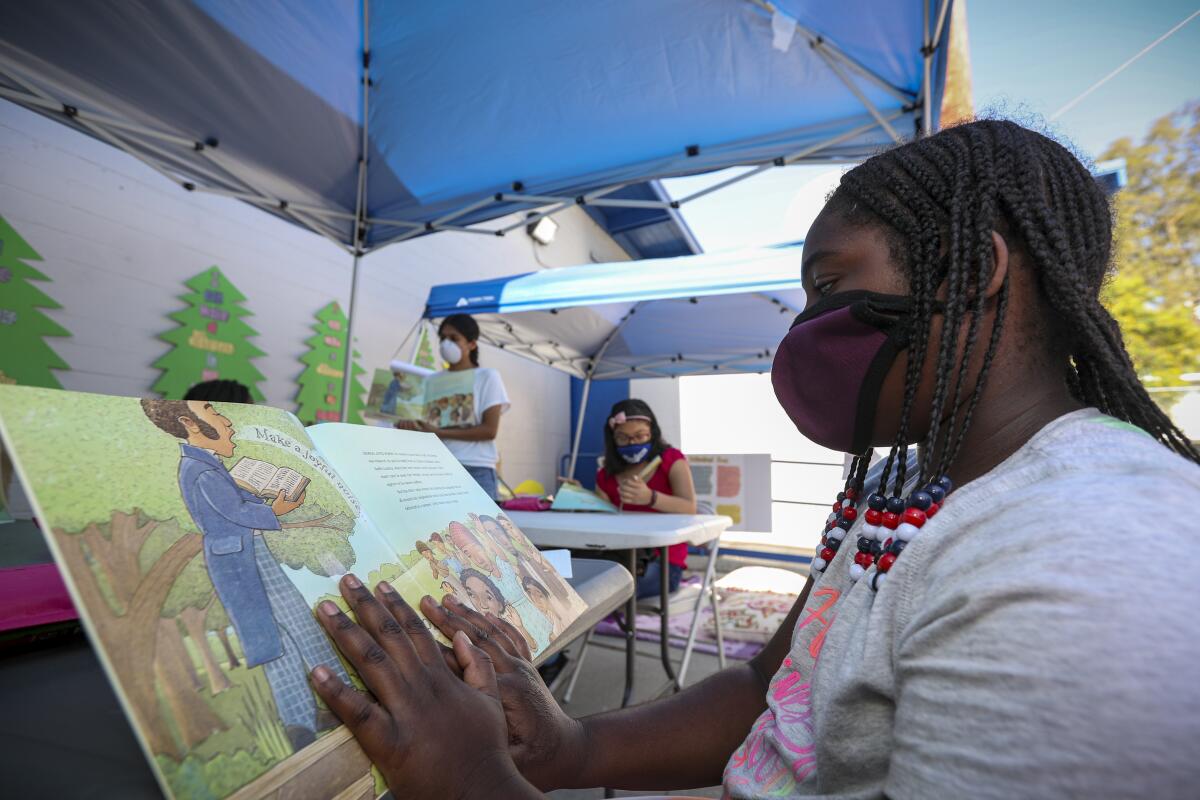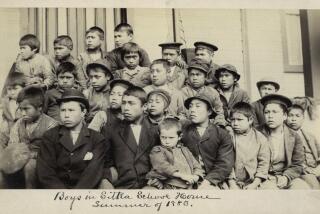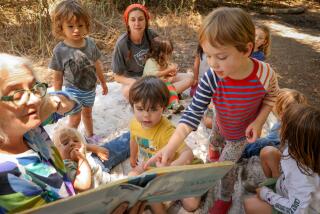At Freedom Schools, empowering Black and Latino students is part of the lesson plan

The lesson that July day told of a slave who taught himself how to read, then became such an accomplished poet that young white men paid him to write verses to their girlfriends.
If the slave, George Moses Horton, charged 25 cents a poem and sold 12 poems in a week, how much did he earn? Itzel Gama asked a small group of third- to fifth-graders after they had read a book about Horton.
The students called out their answers through masks under a white tent in the Pueblo del Rio public housing development in South Los Angeles. After the math exercise, they would pen their own poems.
For Gama’s students and the 30 or so others in the Freedom Schools program at Pueblo del Rio, it has been a summer like no other, amid a surging coronavirus crisis and a national movement against police brutality following the killing of George Floyd.
Since 1995, Freedom Schools have filled the summers of mostly Black and Latino children from low-income households around the country providing lessons and books about people who look like them — a boy of Puerto Rican heritage trying to make friends, a Black boy in Chicago making sense of his classmate’s death by gang violence.
While strengthening their reading, writing and math skills in the six-week program, the students learn that they, too, can change the world — an especially relevant lesson given the ongoing upheaval.
“Over the summer, we’ve basically been teaching the kids a lot about their history and the barriers we have to go through,” said Cory Butler, site coordinator for Pueblo del Rio’s Freedom School. “Getting them to understand where we come from will better help them understand where we are going.”
Founded by the Children’s Defense Fund, the Freedom Schools were modeled after schools of the same name established in Mississippi in the summer of 1964 to teach Black history, leadership skills and the tenets of the civil rights movement, as well as basic literacy. The fund oversees the program, which operates at more than 180 sites around the country, but each school pays its own way.
“It is the pedagogy of empowerment. That is what Black and brown children need,” said L.A. County Supervisor Mark Ridley-Thomas, a longtime proponent of the program. “They need a sense of affirmation that causes them to know that they can do it in spite of adversity.”
Freedom School teachers are college students or recent graduates from the area. They get summer jobs and teaching experience, while the students get role models.
The students pay no fees and receive free meals while attending classes. This year, the Pueblo del Rio program, which mostly served students who live in the housing development, struggled to pay its expenses, despite a grant from L.A. County that covered books and training.
Alfredo Gama, a volunteer with the program, started a GoFundMe for basics such as meals, teacher salaries and coronavirus hygiene supplies.
COVID-19 also forced the cancellation of many summer programs and hit Black and Latino families especially hard with job losses and illness.
“This summer gap is very crucial, especially for our children that are in low-income environments,” said Clarke Patterson, a teacher at the Pueblo del Rio site. “It’s important that we can close that gap a little bit, so that for the upcoming year, they’re not behind.”
Because of coronavirus concerns midway through the program, the Freedom School had to move out of a recreation center at Pueblo del Rio to a smaller outdoor location under two tents. The classes had to be staggered, with kindergartners to second-graders meeting in the mornings and third- to eighth-graders in the afternoons. Noise from the nearby train tracks was a distraction. Some students dropped out, and its 35-student attendance dropped by about half.
The program wrapped up days before the first day of online classes in the L.A. school district. To further support students, two Freedom School teachers are looking for funding for a mentoring center at Pueblo del Rio that would provide internet access and help students with online homework during the school year.
For now, Freedom School graduates are heading into their online schooling with a newfound sense of themselves and their history.
Alex, 9, enjoyed reading “Yummy: The Last Days of a Southside Shorty,” a graphic novel by author G. Neri and illustrator Randy DuBurke based on a true story of an 11-year-old boy whose classmate was killed in a gang shooting.
Assigned to create his own comic book, Alex decided to write a more hopeful ending and portray the shooting victim more positively.
“I made drawings that made him nicer, and that was better than just having anything to do with gun violence,” said Alex, whose guardian asked that his last name not be used because he is in foster care.
Some students are reflecting about what they learned in the context of this summer’s protests against police treatment of Black and Latino people.
“Freedom Schools is helping people learn about their equal rights, and now, since stuff has been happening, Freedom Schools is even more into it,” said Marina Delavega, 13.
For Cherish Purnell, 14, the program itself is a form of protest, rooted in understanding each other better rather than marching in the streets.
“I feel like Freedom Schools is a protest to bring all colors together to help us learn about each person’s background and experiences,” she said.
Frank Rojas is an editorial assistant with The Times. He was a Freedom Schools teacher in 2017.
More to Read
Sign up for Essential California
The most important California stories and recommendations in your inbox every morning.
You may occasionally receive promotional content from the Los Angeles Times.











